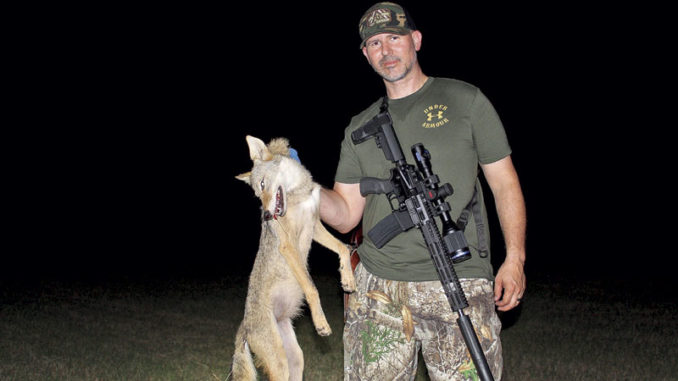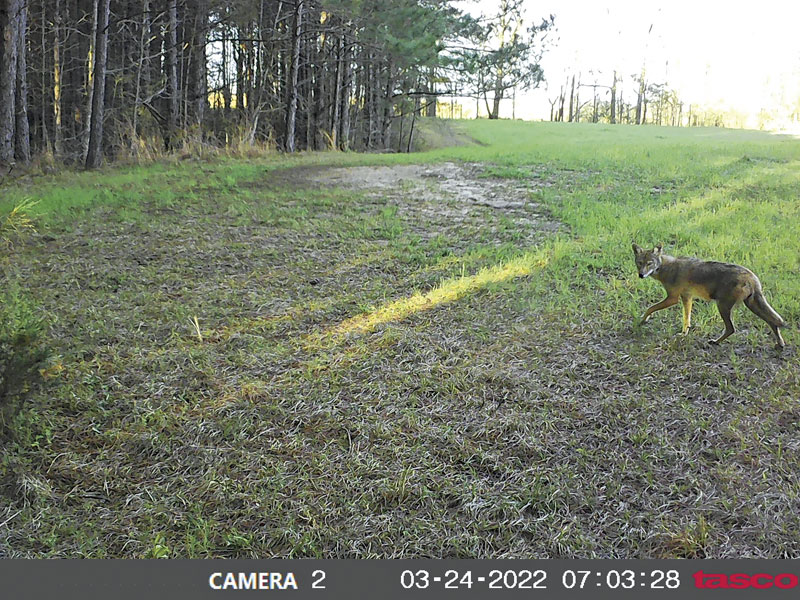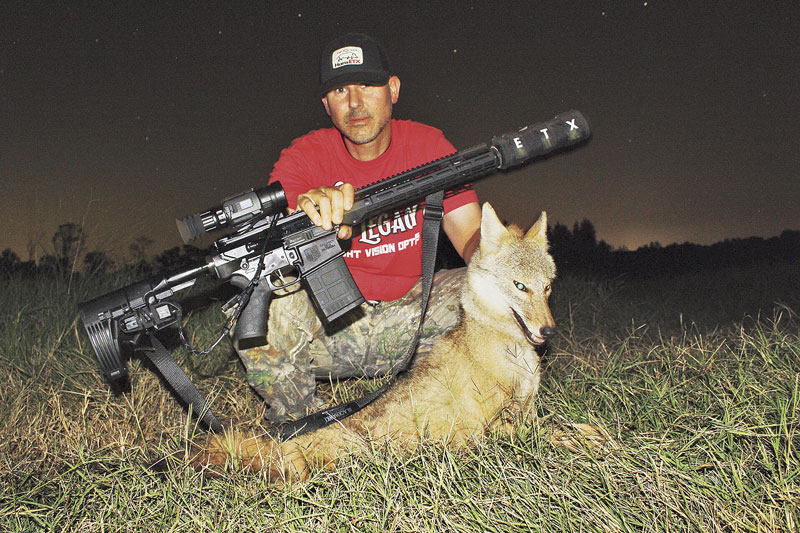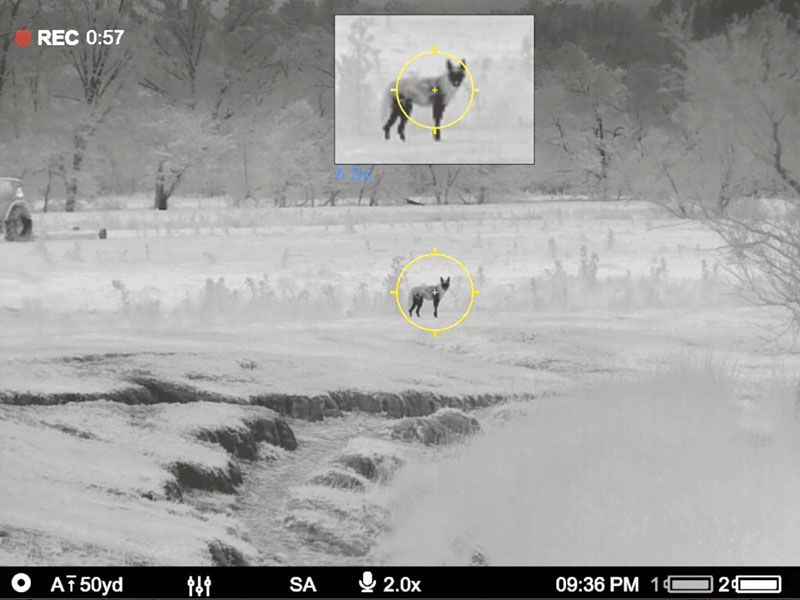
There are various reasons hunters try and take out a few coyotes throughout the year.
It’s not just turkey and deer hunters protecting their game, either. With a healthy increase in coyote populations — farmers, ranchers and even pet owners have joined the ranks of predator hunters using thermal optics and night vision. They are waging war on one of the most hated and feared predators that walk the outdoors — the coyote.

Hunt this summer
The cooler February breeding season is long gone, and adult coyotes are on the hunt, trying to feed pups. They are after anything easy and are especially devastating to the deer herd when fawns are being born and are young. Summer is here, and it’s prime time.
“I have a lot of success during the summer months coyote hunting at night. They are on the move looking for small game to feed their young ones. Rabbit distress and woodpecker distress calls will bring them in,” said Joel “Hans” Miller of the Hans ETX YouTube Channel. “Sometimes, though, you have to get out there and see what works well in your area.”

Hunt at night
During hot summer months, it only stands to reason that coyotes will be more active and move at night vs. daylight hours.
“I keep game cameras out during summer, and I get way more pictures at night than daytime — they are bedded down, finding shade and trying to keep cool,” said Miller, a resident of Ben Wheeler, Texas.
Hunters must hunt whenever they have the chance, but the night is the best choice for summer when there is a choice.
“Yes, night hunting coyotes is better. I may be a little biased because I sell thermal optics,” Miller said. “But, I talk to coyote hunters from all over the country every day. Many buy a second thermal scope or upgrade to a different thermal scope. Most of them say that they have hunted coyotes during the day all their lives, but now are having much more success at night. “Coyotes are more likely to come to a call, are more likely to come closer, and are far less skittish during the night.”
Miller also works at Outdoor Legacy, specializing in night vision and thermal optics sales.
Hunters can rest assured that when it comes to hunting coyotes at night during the summer months, they will have plenty of opportunities.

When to hunt
As the sun sets on hot summer days, temps cool, and coyotes start to prowl and look for opportunistic meals. When is the best time to go? There are many nighttime scenarios: full moon, new moon, before moonrise, after moonset, dusk, or dawn. Miller has some sound advice.
“I hunt whenever I can hunt—and that’s most people too. My buddy Jason says the best time to hunt is when you can go out and do it. So that’s my philosophy.”
You can only hunt as your work schedule and family duties allow. It can be tough hunting at night and staying rested. Plan your hunts ahead of time or develop a routine.
“I usually get the kids in bed by 8:30 or 9:00 p.m., and I go out and hunt for a couple of hours,” Miller said. “I may hunt a little longer on the weekends.”
If hunters have options on which nights to hunt, darker nights and darker times of the night would be a better choice.
“There is no science behind this, but from as many years as I have night hunted and as often as I do, everything comes out later on a full moon night. It seems like coyotes will be out later than normal; instead of coming out 9 -12 p.m., they seem to be out 2 – 3 a.m. I usually don’t like to hunt full moon nights, but hey, you have to hunt when you can,” said Miller, “And on a new moon night, everything seems a little earlier.”

Set-ups
When you set up to call, obviously consider the wind. Coyotes will almost always approach the caller from downwind.
“We try to set up and call them out of the woods or thickets into an opening or a field,” Miller said.
Moonlight brightness is another consideration. When a coyote is coming to a call, he may approach from downwind, but he can see very well, especially in the moonlight. On bright nights, hunters should stand under a tree and catch some shade from the moonlight.
“On a really bright night, I like to stand in front of a big tree so it will break my silhouette,” Miller said. “If I can, I will try and keep the moon over my shoulder so that when the coyote approaches, it’s looking into the moonlight and will be a little more blinded.”
The darker the night, the less you will have to hide or be particular about hiding, such as a new moon, a cloudy night, before moonrise, or after moonset.
Calling is not the only way to set up for killing the “song dog.” Hunters can hide and wait, sort of like still-hunting. Setting up near cattle is an excellent strategy as coyotes are constantly harassing and stalking them under cover of darkness.
Hunting over dead animals is another set-up that works well. Still-hunting or calling is more effective in this scenario. Cattle farmers will often drag dead cows to specific areas on their property, and this could be a coyote bonanza if you can obtain permission to hunt.
“We dump out dead pigs that we have shot in a certain area,” Miller said. “I often come back to this spot a few nights after dumping some and hunt coyotes. This has been very productive.”
Dead cows, dead pigs or gut piles at hunting clubs are good coyote night hunting places to think about. If you or your neighbor dump table scraps consistently in the same spot on the fringes of your property, this could be another option.
Provide a distraction
When setting up an electronic caller, utilize a decoy. Day hunters use them regularly, and night hunters should do the same.
“Even at night on my Lucky Duck caller, I will still run my decoy —the little tail that slings around,” Miller said. “The coyote may catch that decoy movement drawing their attention and they are less likely to spot you, especially on a bright night.”
Wrap-up
Finding success at coyote night hunting is simply understanding a few basic things. A coyote will always rely on its keen sense of smell first, so always play the wind. Position yourself and hide as well as you can using the shadows and the cover of darkness. Coyotes are at ease and move more at night. Hunt when you can and as often as you can, remember the basics, and you will have the advantage.

Don’t stop just because you got one!
Joel “Hans” Miller is a nationally renowned coyote night hunting expert and one of The Late Night Vision Showpodcast and YouTube Channel hosts. Miller has noticed a behavior pattern of coyotes located in areas where there is regular hog hunting.
“Here is a little secret that has been working well for me. In an area where we pig hunt, it seems like the coyotes will come to the gunshot when we shoot,” he said. “Many times after I’ve shot a hog, a coyote has shown up. So, if I shoot a pig in a field, I will sit there a while because there is a good chance that a coyote will show up. I’ve taken several coyotes after killing a hog.
“This goes along with what I just said, and I learned this from someone else. After you call in and shoot one coyote, don’t pack up and leave. Keep calling and keep sitting. Some friends and I won a coyote hunting contest earlier this year in February just because when we would shoot a coyote, we would leave the caller running. We would get another one or two dogs after we shot the first. We even had coyotes run past a dead coyote coming to the caller. “
Keep that call running after you shoot for at least another 10 minutes, said Miller.